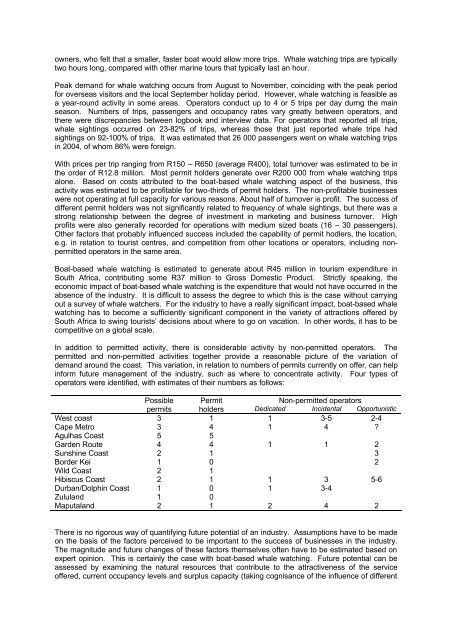Download PDF (2.5MB) - Anchor Environmental
Download PDF (2.5MB) - Anchor Environmental
Download PDF (2.5MB) - Anchor Environmental
You also want an ePaper? Increase the reach of your titles
YUMPU automatically turns print PDFs into web optimized ePapers that Google loves.
owners, who felt that a smaller, faster boat would allow more trips. Whale watching trips are typically<br />
two hours long, compared with other marine tours that typically last an hour.<br />
Peak demand for whale watching occurs from August to November, coinciding with the peak period<br />
for overseas visitors and the local September holiday period. However, whale watching is feasible as<br />
a year-round activity in some areas. Operators conduct up to 4 or 5 trips per day durng the main<br />
season. Numbers of trips, passengers and occupancy rates vary greatly between operators, and<br />
there were discrepancies between logbook and interview data. For operators that reported all trips,<br />
whale sightings occurred on 23-82% of trips, whereas those that just reported whale trips had<br />
sightings on 92-100% of trips. It was estimated that 26 000 passengers went on whale watching trips<br />
in 2004, of whom 86% were foreign.<br />
With prices per trip ranging from R150 – R650 (average R400), total turnover was estimated to be in<br />
the order of R12.8 mililon. Most permit holders generate over R200 000 from whale watching trips<br />
alone. Based on costs attributed to the boat-based whale watching aspect of the business, this<br />
activity was estimated to be profitable for two-thirds of permit holders. The non-profitable businesses<br />
were not operating at full capacity for various reasons. About half of turnover is profit. The success of<br />
different permit holders was not significantly related to frequency of whale sightings, but there was a<br />
strong relationship between the degree of investment in marketing and business turnover. High<br />
profits were also generally recorded for operations with medium sized boats (16 – 30 passengers).<br />
Other factors that probably influenced success included the capability of permit hodlers, the location,<br />
e.g. in relation to tourist centres, and competition from other locations or operators, including nonpermitted<br />
operators in the same area.<br />
Boat-based whale watching is estimated to generate about R45 million in tourism expenditure in<br />
South Africa, contributing some R37 million to Gross Domestic Product. Strictly speaking, the<br />
economic impact of boat-based whale watching is the expenditure that would not have occurred in the<br />
absence of the industry. It is difficult to assess the degree to which this is the case without carrying<br />
out a survey of whale watchers. For the industry to have a really significant impact, boat-based whale<br />
watching has to become a sufficiently significant component in the variety of attractions offered by<br />
South Africa to swing tourists’ decisions about where to go on vacation. In other words, it has to be<br />
competitive on a global scale.<br />
In addition to permitted activity, there is considerable activity by non-permitted operators. The<br />
permitted and non-permitted activities together provide a reasonable picture of the variation of<br />
demand around the coast. This variation, in relation to numbers of permits currently on offer, can help<br />
inform future management of the industry, such as where to concentrate activity. Four types of<br />
operators were identified, with estimates of their numbers as follows:<br />
Possible Permit<br />
Non-permitted operators<br />
permits holders Dedicated Incidental Opportunistic<br />
West coast 3 1 1 3-5 2-4<br />
Cape Metro 3 4 1 4 <br />
Agulhas Coast 5 5<br />
Garden Route 4 4 1 1 2<br />
Sunshine Coast 2 1 3<br />
Border Kei 1 0 2<br />
Wild Coast 2 1<br />
Hibiscus Coast 2 1 1 3 5-6<br />
Durban/Dolphin Coast 1 0 1 3-4<br />
Zululand 1 0<br />
Maputaland 2 1 2 4 2<br />
There is no rigorous way of quantifying future potential of an industry. Assumptions have to be made<br />
on the basis of the factors perceived to be important to the success of businesses in the industry.<br />
The magnitude and future changes of these factors themselves often have to be estimated based on<br />
expert opinion. This is certainly the case with boat-based whale watching. Future potential can be<br />
assessed by examining the natural resources that contribute to the attractiveness of the service<br />
offered, current occupancy levels and surplus capacity (taking cognisance of the influence of different
















